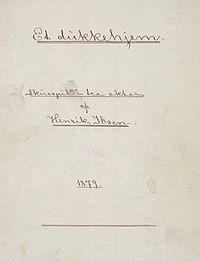
The art of translation, taken back to its Latin roots, involves a carrying-over. But what does one carry over?
Translators like to maintain their devotion to retaining the “original meaning” of the text (and I have been just as guilty of this in the past as any). If by “meaning” we mean “what the author really said,” the endeavor is futile. The author has already said what he wanted to say, in a language probably incomprehensible to the audience the translator wishes to reach.
So we become less audacious, and say that we want to preserve the “sense” of the original. But this, too, is no mean task. Language is not a transparent medium, in which meaning is easily transferable from one tongue to another. That we regularly misunderstand those speaking in the same language as ours testifies to this truth.
Many of the more daunting obstacles I’ve faced as a translator have been removed in my approach to A Doll’s House: the work is a relatively recent one (for a medievalist such as myself, anyway); the characters do not speak in verse; the bourgeois setting involves concerns familiar to one raised in such surroundings. The problems that remain are the ones that always attend the project of translation: how to represent words from a different language and time in a manner by which the characters retain their individual voices (if the author has been careful enough to provide them), and the manner and mood of the scenes, insofar as they are created by language, are upheld.
With A Doll’s House, the major challenge was to mitigate the tendency in Scandinavian languages toward prolixity (tedious wordiness). Ibsen’s dialect, Dano-Norwegian, retains the fondness for subordinate clauses common to Germanic languages. Carrying this kind of syntax into English results in a style that strikes the modern ear as rather stilted or overly formal. I’ve retained some of that kind of diction where appropriate, notably for Dr. Rank, whose macabre sense of humor is well-served by it, or for Helmer in his more priggish moments. Whereas for Nora, I’ve tried to combine clauses, even truncate them, in order to give her speech a sense of breathlessness, of headlong motion. In two scenes in Act 3—that between Mrs. Linde and Krogstad, and the final scene between Nora and Helmer— I’ve extended this practice of consolidation, compressing exchanges between characters by removing superfluous responses or recapitulations.
On the level of diction, I’ve tried to adopt a style appropriate to middle class individuals of the late nineteenth century, interpreted into an American idiom rather than a British one. At times the natural reticence of the Scandinavian character provides challenges in this regard. When Nora tells us she dearly wants to say something rude that Helmer will hear, her outburst might be translated literally as “death and torment!” Here, as elsewhere, I have taken liberties in translation to compensate for the paucity of hyperbolic expression available in Nordic languages.
I hope, as always, that my labors on this translation will provide the audience with as much pleasure as it has to me. The great reward of the translator’s work is that it obliges him to slow down and listen very carefully. It’s in this deliberation I often find the true pleasure of the text.
— Sean Patrick Taylor, A Doll’s House translator
